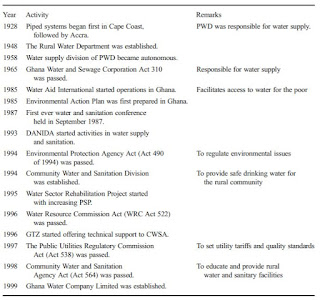Since
the 1990’s, non-governmental organizations (“NGOs”) have become one of the most
influential actors in the water politics of Africa. For instance, in Kenya from
1996 to 2003, the number of registered NGOs grew explosively, from 511 to over
2,500 total organizations (Hearn, 2007). Also, estimates now show that NGOs may be supplying
more capital into African infrastructure development projects than the World
Bank (Mohan,
2002). Given I have not addressed them yet, this final blog post seems like
a good opportunity to discuss their effectiveness in influencing water
infrastructure development across Africa.
A
key important aspect of how NGOs are intended to operate is in their name: they
are non-governmental. This deliberate separation of organisation from state
allows them to remain detached from the agendas of developed countries. However,
they are widely criticized for how they have become increasingly politicized as
they seek funding which often ties them to donors with western agendas. For
instance, although the primary goal of development NGOs is to positively
influence the promotion of economic development, Gosh, 2009 asserts that their credibility is hampered by how they
are accountable to their donors and not their beneficiaries. Thus, there arise
conflicts of interest where donors may levy their position to insist on certain
projects versus others that may not necessarily be in the best interests of a
community.
Zakiya,
2014 describes this complex relationship as “philanthrocapitalism” where
wealthy angel investors link their funds through NGOs into the developing world
under the mask of corporate responsibility. This creates the problem of
“quantiphilia” where NGOs are not just interested in helping communities grow
and expand their water infrastructure, networks and economy, but they are
fixated on measurable results to report, leading to a system where data and
algorithms may hold more input to water investment allocation than the input of
local political actors. This issue is amplified by the distances between donors
from the water consumers, removing influential decision-makers from the reality
of the field, shown below.
Figure
1: Path From International NGO To Water Provision, Rusca
and Schwartz, 2012
However,
the fact that local peoples have significantly greater understanding of the
local ecology and water needs in their community is not lost on NGOs. They are
typically efficient in utilising indigenous knowledge to improve the overall
efficiency of water development projects. NGOs tend to be advocates of
endogenous development as well, where the water project is designed to meet the
local criteria and needs of the community, and they are responsible for the
project to build a sense of identity with it. Mixing these two together allows
for a project to be “by the people, for the people” and creates community
solidarity and cooperation in a project. However, some academics are concerned
that, similar to reservations that IWRM is becoming simply a “prescription”
pill to issue to local communities on water management (Giordano
and Shah, 2013), the use of indigenous knowledge and endogenous development
may become just another “development fad” used by NGOs while still serving
western interests (Fernando,
2003).
Reading
through articles and literature on NGO project outcomes, I noticed most optimistic
reports come from dialogue created by NGOs and critical reports come from scientific
literature. Rusca and Schwartz, 2012 paints a picture of how WaterAid, one of
the largest NGOs in water development, implements projects via a case study of two
programs in Lilongwe and Maputo. In both cases, the objectives involved creating
a centralized water management system and the implementation of a tariff
collecting system. In both cases, projects were successful in expanding water
access networks in both cities, but two concerning trends were noted: 1) the
billing system was concerningly high, representing on average 9% of the minimum
wage per month, with projects only built in targeted areas with high ability-to-pay,
and 2) although sustainability was initially claimed as a primary goal, “relevant
aspects for long-term sustainability, such as technical and operational aspects
of water services, were neglected” (Rusca
and Schwartz, 2012). The authors note that the issue with high water
tariffs results from the results-oriented structure WaterAid is subject to in
donor reporting, whereas the sustainability concerns arose from weak
integration of the local political structures to gain consent on the scope of
the project and ensure community participation.
However,
not all literature is critical of NGOs and their outcomes in water projects. Bratton,
1989 asserts that in measuring how successful NGOs are in their goals, it
must be done objectively and empirically, and success measurements must be
checked by monitoring the NGO. He also comments on how most positive reports
are generated internally by NGOs but agrees that evidence defends how assistance
from NGOs has been shown to improve certain necessary health services, such as
sanitation and water access. Moreover, it appears that NGOs can also be more
effective in addressing water issues in Africa due to the motivation of field
staffs, who often care greatly for the project outcome and people it affects.
I
don’t intend to overly criticize NGOs. They have placed more funds into
developing the water provisioning systems of Africa than almost any other community.
They rely on dedicated staff who truly care to help the people they serve, and outcomes
are often successful. However, akin to my commentary on the World Bank, there
arises considerable structural concerns that degrade their ability to fully address
water development. This tends to reflect what may be the greatest issue of development
in Africa: western assistance there needs to avoid looking for quantifiable
results or investment opportunities, and simply allow Africa to develop on its
own terms while providing knowhow and assistance with the process.








